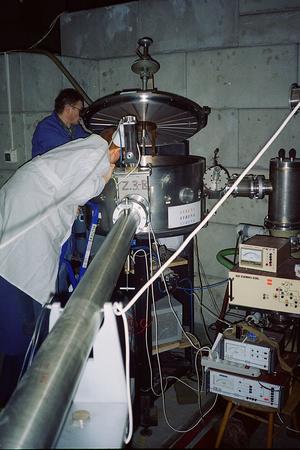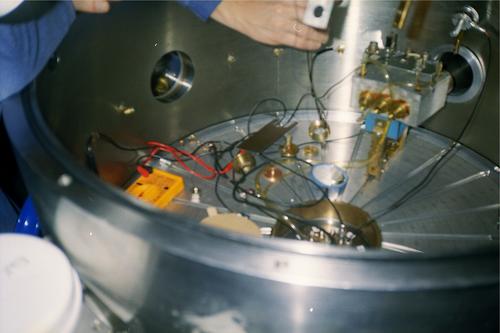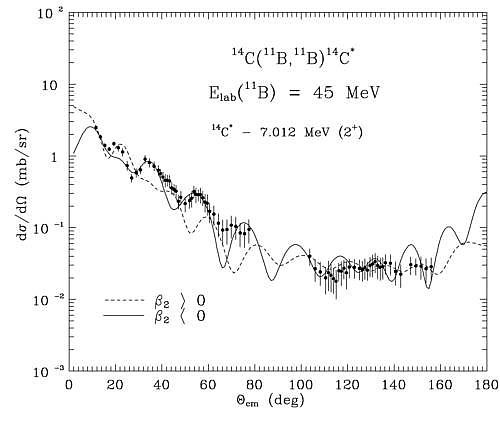Reakcje z lekkimi jonami
Wersja polska w przygotowaniu…
REACTIONS WITH LIGHT NUCLEI
Nuclear reactions group: Cracow – Kiev – Warsaw
Andrzej Sołtan Institute of Nuclear Studies, ul. Hoża 69, 00-681 Warsaw, Poland
K.Rusek, S. Yu. Mezhevych
Institute of Nuclear Research, Prospect Nauki 47, 03680 Kiev, Ukraine
A.T.Rudchik, V.M. Kyryanchuk, A.V. Mokhnach, O.A. Momotyuk, Val.M. Pirnak, O. Ponkratenko, V. Romanyshyn, A.A. Rudchik
H.Niewodniczański Institute of Nuclear Physics, ul. Radzikowskiego 152, 31-342 Cracow, Poland
A. Budzanowski, B.Czech, S.Kliczewski, R. Siudak, I.Skwirczyńska
Kharkiv State University, 61077 Kharkiv, Ukraine
E.Koshchy
Heavy Ion Laboratory of Warsaw University, ul. Pasteura 5A, 02-093 Warsaw, Poland
T. Czosnyka, J. Choiński, A. Stolarz
Military University of Technology, ul. Kaliskiego 2, 00-908 Warsaw, Poland
L.Głowacka
Contact: Krzysztof Rusek, Krzysztof.Rusek(at)fuw.edu.pl
Nuclear reactions are the main source of experimental information on the structure of nuclei, mechanisms of nuclear processes and properties of nucleus-nucleus interaction. This information, for instance, may be obtained from the theoretical analysis of angular distributions of the measured reaction products. The present theoretical models used for such an analysis are parameterized, and the parameters describing nuclear structure, mechanisms of reactions and nucleus-nucleus interactions are closely related to each other. Therefore, for the reliable determination of these parameters a broad set of experimental data is demanded for reactions with different nuclei in the entrance and exit channels and at different energies. Thus, obtaining new experimental data remains an urgent task in nuclear physics.
We perform experiments with the 10B3+, 11B2+, 12C2+, 14N3+ and 18O4+ ion beams, accelerated at Warsaw Cyclotron U-200P up to an energy of 5-10 MeV/A, which are scattered from the 6,7Li, 9Be, 12,13,14C targets. The experimentally obtained angular distributions of the reaction products are analyzed by means of the coupled-reaction-channels method, and the parameters describing the structure of the nuclei, mechanisms of nuclear reactions and nucleus-nucleus interactions are deduced. We start with the investigation of the elastic and inelastic scattering in order to obtain a reliable set of optical model parameters describing the nucleus-nucleus interaction in the entrance channel, which are then employed in the calculations of different transfer processes leading to the production of the experimentally observed nuclei in the exit reaction channels.
EXPERIMENTAL SETUP “SYRENA” AT WARSAW CYCLOTRON
The setup is located in section “B” of the experimental hall of the Heavy Ion Laboratory of Warsaw University. The picture of the scattering chamber is shown in Fig.1. In the center of the chamber a frame with targets is fixed on a movable rod. The scattering chamber has two movable platforms on which the detectors are mounted. Three-channel ΔE-E spectrometer, with the gas-filled ionization chamber serving as the ΔE – detector, is mounted on the lower platform (see Fig.2). At the backward side of the ionization chamber silicon E-detectors (approx. 500 μm), stopping the reaction products, are mounted. Angular separation between the channels is 9.5o. On the upper platform the second ΔE-E spectrometer consisted of the silicon ΔE (approx. 60 μm) and E (approx. 500 μm) detectors is placed.
Figure 1: Scattering chamber of the experimental setup “SYRENA”.
Figure 2: The scattering chamber in the inside.
In Fig.3 a typical two-dimensional energy spectrum of the 7Li(12C,X) reaction products at Elab(12C) = 115 MeV registered at Θlab = 15o by the silicon ΔE-E spectrometer is shown. Very good energy resolution of the detectors leads to a good separations between Li, Be, B, C and N isotopes.
Figure 3: ΔE-E spectrum of the 7Li(12C,X) reaction products.
RESULTS OBTAINED USING THE BEAM FROM THE WARSAW CYCLOTRON
So far we have published five papers (see the list below). They contain new experimental data sets as well as many interesting conclusions drawn from the data analyses. As an example we present in Fig. 4 the angular distribution of the inelastically scattered 11B from 14C target leading to the excitation of the 7.012 MeV (2+) excited state of 14C. The curves present results of the coupled-channels calculations. Collective model of the target nucleus was assumed. The short dashed curve was obtained assuming the positive quadrupole deformation (β2 = +0.2) of 14C, while the solid curve was obtained with the negative quadrupole deformation (β2 = -0.2.).
Figure 4: The results of the calculations compared to the experimental data.
BIBLIOGRAPHY
(The experimental data obtained at Warsaw Cyclotron serves as the experimental material for four PhD theses as well as two DSc dissertations)
- A.T.Rudchik, A.Budzanowski, V.K.Chernievsky, B.Czech, L.Glowacka, S.Kliczewski, A.V.Mokhnach, O.A.Momotyuk, S.E.Omelchuk, V.M.Pirnak, K.Rusek, R.Siudak, I.Skwirczynska, A.Szczurek, L.Zemlo,
The 11B + 12C Elastic and Inelastic Scattering at Elab(11B) = 49 MeV and Energy Dependence of the 11B + 12C Interaction,
Nucl.Phys. A695, 51 (2001) - S.Yu.Mezhevych, K.Rusek,
Quadrupole deformation of 11B (3/2-, 5.02 MeV) excited states from 11B + 12C scattering,
Acta Phys.Pol. B34, 2415 (2003) - A.T.Rudchik, V.M.Kyryanchuk, A.Budzanowski, V.K.Chernievsky, B.Czech, T.Czosnyka, A.V.Glowacka, S.Kliczewski, E.I.Koshchy, S.Yu.Mezhevych, A.V.Mokhnach, K.Rusek, S.B.Sakuta, R.Siudak, I.Skwirczynska, A.Szczurek, L.Zemlo,
Mechanism of large angle enhancement of the 9Be+11B scattering,
Nucl.Phys. A714, 391 (2003) - S.Yu.Mezhevych, K.Rusek, A.T.Rudchik, A.Budzanowski, V.K.Chernievsky, B.Czech, J.Choinski, L.Glowacka, S.Kliczewski, E.I.Koshchy, V.M.Kyryanchuk, A.V.Mokhnach, A.A.Rudchik, S.B.Sakuta, R.Siudak, I.Skwirczynska, A.Szczurek, L.Zemlo,
The 13C + 11B elastic and inelastic scattering and isotopic effects in the 12,13C + 11B scattering,
Nucl.Phys. A724, 29 (2003) - V.M.Kyryanchuk, A.T.Rudchik, A.Budzanowski, V.K.Chernievsky, T.Czosnyka, B.Czech, L.Glowacka, S.Kliczewski, E.I.Koshchy, S.Yu.Mezhevych, A.V.Mokhnach, K.Rusek, S.B.Sakuta, R.Siudak, I.Skwirczynska, A.Szczurek, L.Zemlo,
One-nucleon transfer reaction 9Be(11B, 10B)10Be and optical potential for the 10B + 10Be interaction,
Nucl.Phys. A726, 231 (2003) - S.Yu.Mezhevych, K.Rusek, A.T.Rudchik, A.Budzanowski, B.Czech, J.Choinski, L.Glowacka, S.Kliczewski, E.I.Koshchy, V.M.Kyryanchuk, A.V.Mokhnach, A.A.Rudchik, S.B.Sakuta, R.Siudak, I.Skwirczynska, A.Szczurek,
Structure of 14C from 11B + 14C scattering,
submitted to Nucl.Phys. A - A.A.Rudchik, A.T.Rudchik, A.Budzanowski, A.Szczurek, B.Czech, T.Czosnyka, J.Choinski, L.Glowacka, S.Kliczewski, E.I.Koshchy, S.Yu.Mezhevych, A.V.Mokhnach, O.A.Momotyuk, Val.M.Pirnak, R.Siudak, I.Skwirczynska,
Mechanism of 12C(11B,15N)8Be reaction and 8Be + 15N optical model potential,
submitted to Eur. Phys. J. A





